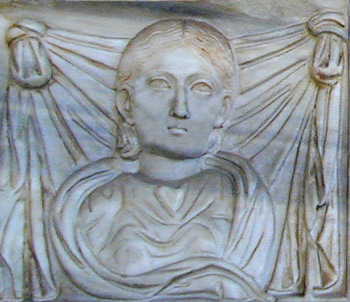 |
Aurelia Agrippina and her husband Publius Aelius Myron, are depicted on the lid of a large marble sarcophagus on which the battle of Achilles and Penthesilea is sculpted, along with many other figures. The inscription which separates their images is written in archaic Roman capitals dating to the Roman Republican period. Myron dedicates this doubtless expensive sarcophagus to his wife and their children, who must have predeceased him. The portrait busts of the couple are placed on either side of the lid in front of curtains of honor. Agrippina is pictured in the hairstyle and stola and palla of a matrona (see women's dress), while Myron proudly wears the toga of the Roman citizen. Upon manumission freed slaves gained Roman citizenship, but usually retained their servile cognomina (see names).
 |
P[ublius] AE[li]US MYRON AURELIAE AGR[i]PPINAE |
| CO[N]IUGI SANCTISSIMAE ET AELI[i]S | |
| ARRIAE CRESCENTI FILI[i]S DULCISSIMIS | |
| AEDEM A[ere] S[u]O FECIT |
Click on the underlined words for translation aids and commentary, which will appear in a small window. Close this small window after each use.